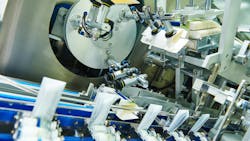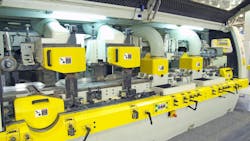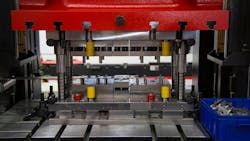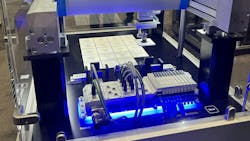Uptime and Automation Among Key Design Objectives for Industrial Machinery
The National Fluid Power Association (NFPA) is currently working on the creation of its next technology roadmap which will focus on fluid power technological development needs for industrial applications. A key first step in developing this document is determining the customer drivers and strategies important to OEMs and machine builders in the industrial market.
These customer drivers and strategies signify desired performance objectives those manufacturing industrial machinery are hoping to achieve. By understanding these, hydraulic and pneumatic companies serving this sector can better ensure they are developing technologies capable of helping meet these objectives.
NFPA decided to launch a new road mapping effort specifically focused on industrial applications in late 2024 because of the continued importance of this sector to the fluid power industry.
What is Considered an Industrial Application?
The National Fluid Power Association (NFPA) groups fluid power customer markets into two main areas — mobile or off-highway equipment and industrial, stationary or in-plant equipment.
Eric Lanke, President & CEO of NFPA, said there can sometimes be confusion about what is considered an industrial application, so the association has worked with its Industrial Technology Task Force to define the 14 large industrial customer markets commonly served by hydraulics and pneumatics:
- Aerospace Manufacturing
- Food Product Machinery
- Medical Equipment Manufacturing
- Metalworking and Machine Tools
- Oil and Gas Machinery
- Packaging Machinery
- Plastics and Rubber Machinery
- Power Generation
- Primary Metals Manufacturing
- Recycling Equipment
- Robotics, Assembly and Material Handling
- Semiconductor Machinery
- Vehicle Manufacturing
- Wood and Paper Machinery
When completed, the industrial technology roadmap will provide “an industry-wide consensus regarding the pre-competitive research and development needs associated with improving the design, manufacture and function of fluid power components and systems specifically for industrial, or sometimes what we call in-plant, applications,” said Eric Lanke President & CEO of NFPA.
On April 24, NFPA hosted a webinar to offer insight on the customer drivers and strategies its technology roadmap committee sees driving the industrial machinery market.
Productivity Remains a Key Performance Objective for Industrial Machinery
Surveys of stakeholders in the industrial market help inform much of the information that will be contained in the NFPA technology roadmap, along with additional input and guidance from the association’s Industrial Technology Task Force.
In January 2025, the first surveys were sent out for the newest roadmap to determine key customer drivers and strategies. Lanke said it received one of the highest response rates NFPA has had for one of its road mapping surveys as well as good representation from across the fluid power supply chain and job functions.
Based on the customer drivers noted in the previous technology roadmap and their relevance to the industrial market, respondents were asked to rank the importance of the following performance objectives machine builders want to offer:
- Increased Availability and Uptime
- Increased Productivity and Performance
- Lower Total Cost of Ownership
- Compliance with Regulations
- Sustainability.
Lanke said there was a lot of variation across the different industrial markets as to which objectives were most important. For instance, compliance with regulations was noted as very important for those in the medical equipment manufacturing and aerospace manufacturing segments — understandable given the public health factor involved with these markets — whereas for other markets this objective was not ranked as highly.
Increased Availability and Uptime and Increased Productivity and Performance were indicated as the most important objectives for all of the industrial markets.
Respondents were also asked to offer suggestions for new customer drivers they consider important for their customer markets. Electrification was a commonly noted driver among several industrial market sectors including aerospace manufacturing, medical equipment manufacturing, packaging machinery, and food product machinery.
Precision Control Ranks as a Top Technological Priority for Machine Builders
NFPA also used its January survey to determine the customer strategies — the machine-level objective or technology machine builders are using or intend to use in order to meet their performance objectives — important to industrial applications.
Respondents were asked to rank the importance of eight different customer strategies which were again determined based on the previous technology roadmap and their applicability to industrial machinery:
- Automation
- Compactness
- Connectivity
- Energy Efficiency
- Maintenance
- Materials
- Noise
- Precision Control.
Similar to the customer drivers, there was wide variation in importance based on market. Connectivity was ranked highly as an important customer strategy for those in the medical equipment manufacturing, vehicle manufacturing, and robotics, assembly and material handling sectors but less so for most other industrial markets.
Lanke said all of the customer strategies appear to be important to some degree based on the survey results, but for most of the industrial markets automation, maintenance and precision control were noted as the most important customer strategies.
Respondents were also asked to offer suggestions for new customer strategies of importance to them. Here again electrification was mentioned for multiple markets including aerospace manufacturing, oil and gas machinery, and metalworking and machine tools. Cost avoidance was another strategy noted as important for multiple markets.
Next Steps for the NFPA Industrial Technology Roadmap
Based on the results of the customer drivers and strategies survey, NFPA’s Industrial Technology Task Force has defined and prioritized those that will be included in the roadmap.
Four Customer Drivers were chosen as those most important for machine builders to provide their customers:
- Increased Availability and Uptime – The robustness of the machine and its ability to work continuously.
- Increased Productivity and Performance – The efficiency of the machine and its ability to do more work in less time.
- Compliance with Regulations – Such as those pertaining to environmental, safety or other concerns.
- Lower Total Cost of Ownership – Includes capital and/or operating costs.
To meet these performance objectives, the task force also denoted the nine key Customer Strategies machine builders are or will be employing:
- Automation – Incorporating either semi- or fully autonomous functions and/or operations on a machine.
- Compactness – Increasing power density of a machine without increasing its weight and/or size.
- Connectivity – Expanding the use of data, such as intelligence for cloud-based condition monitoring, integration with site management systems, and/or communicating machine status for other value-added purposes.
- Electrification – Moving towards electric actuation to improve efficiency or control on the machine.
- Energy Efficiency – Increasing energy efficiency, including strategies to extend operation life, use less energy and/or reduce emissions.
- Environmental Impact – Reducing environmental impact, including strategies to lower noise, reduce leaks and/or use environmentally safe fluids.
- Maintenance and Support – Making it easier to maintain the machine, including strategies to ease initial integration and implementation, to provide documentation support, to ease the serviceability of the machine, and to increase the availability of repair or replacement parts.
- Materials – Use of conflict and/or environmentally-friendly materials in strategic ways to better comply with regulations.
- Precision Control – Improving the ability to manage a system or process on the machine with high accuracy and minimal error, including through the use of sensors.
- Safety – Improving the safe use of the machine.
Want to get involved with the NFPA Industrial Technology Roadmap? Reach out to Eric Lanke at [email protected] to find out how you can help with this and other association projects.
Phase three of the road mapping process is now under way which consists of identifying the capability improvements needed for hydraulics and pneumatics.
“Knowing what we [do] now about the industrial marketplace in terms of what those machine builders are trying to achieve with their machines and what technology strategies they're deploying,” said Lanke will now help the task force determine “how well does fluid power align with those strategies, and what can fluid power be doing differently, or what new developments do we want to see within fluid power so that [it] can either remain or increase its workability as an actuation technology of choice within those strategies.”
NFPA will be using surveys again to collect this and other information for the Industrial Technology Roadmap. It expects to publish the roadmap in November 2025 and plans to update the document once every 4 years to help ensure it continues to offer the most up-to-date guidance on fluid power development needs.
About the Author
Sara Jensen
Executive Editor, Power & Motion
Sara Jensen is executive editor of Power & Motion, directing expanded coverage into the modern fluid power space, as well as mechatronic and smart technologies. She has over 15 years of publishing experience. Prior to Power & Motion she spent 11 years with a trade publication for engineers of heavy-duty equipment, the last 3 of which were as the editor and brand lead. Over the course of her time in the B2B industry, Sara has gained an extensive knowledge of various heavy-duty equipment industries — including construction, agriculture, mining and on-road trucks —along with the systems and market trends which impact them such as fluid power and electronic motion control technologies.
You can follow Sara and Power & Motion via the following social media handles:
X (formerly Twitter): @TechnlgyEditor and @PowerMotionTech
LinkedIn: @SaraJensen and @Power&Motion
Facebook: @PowerMotionTech




